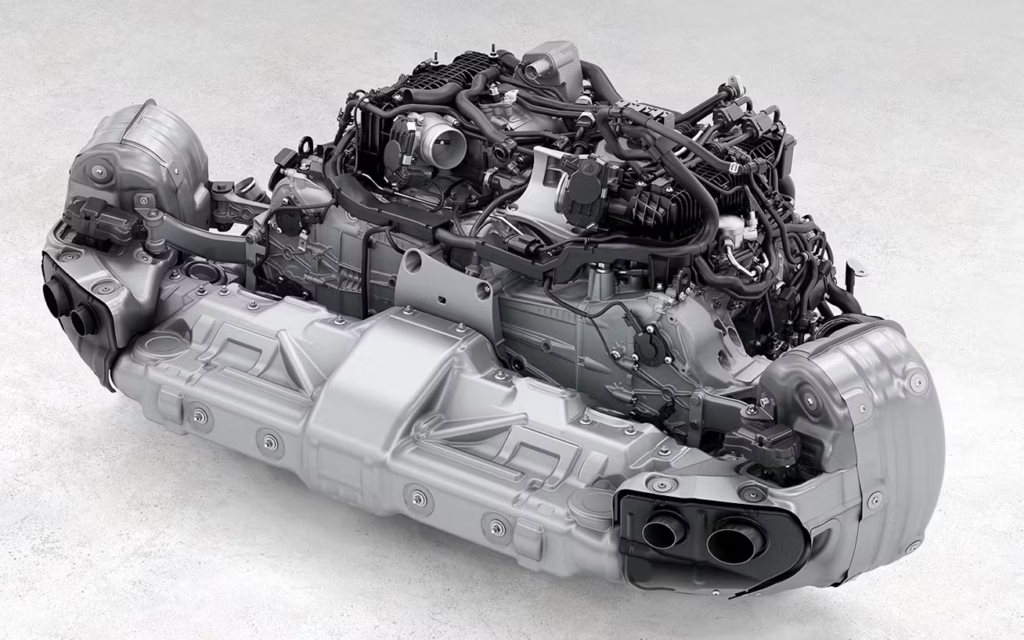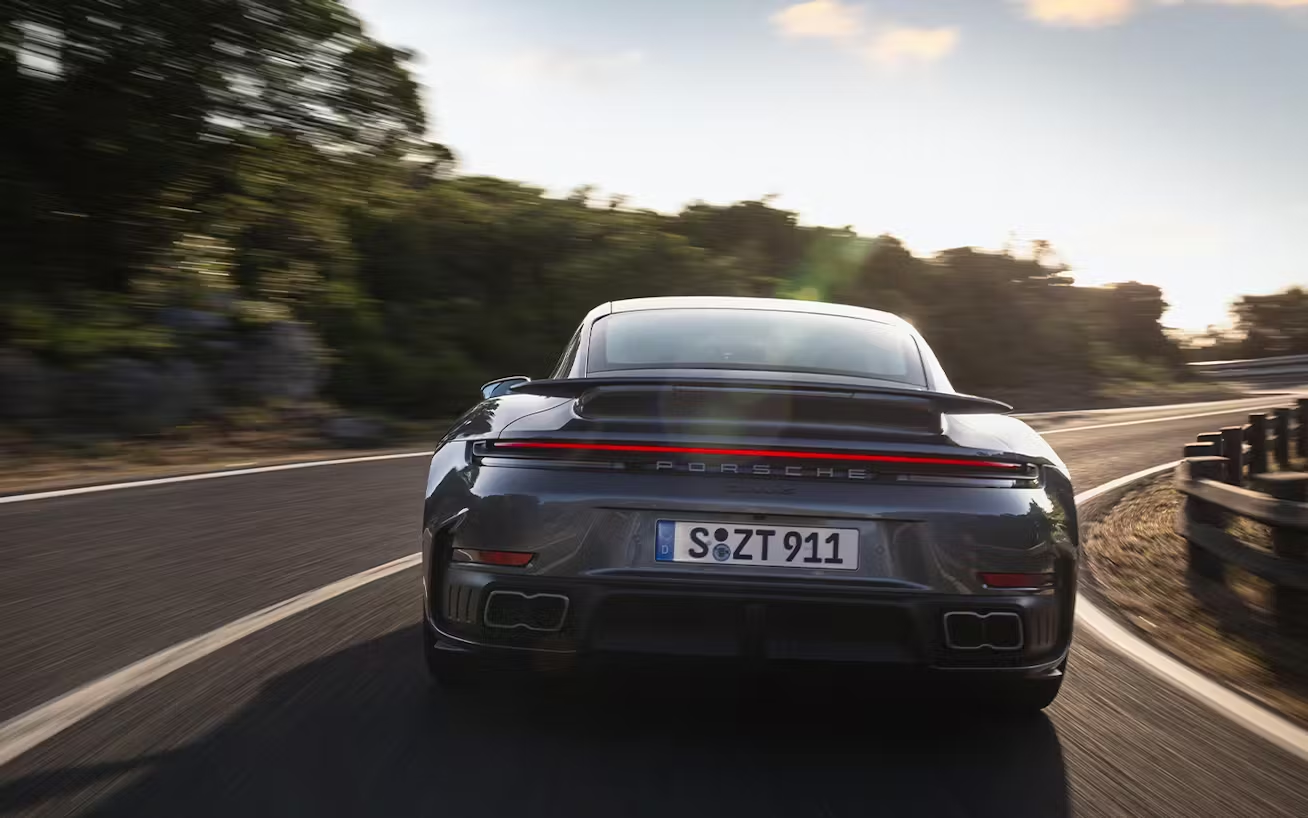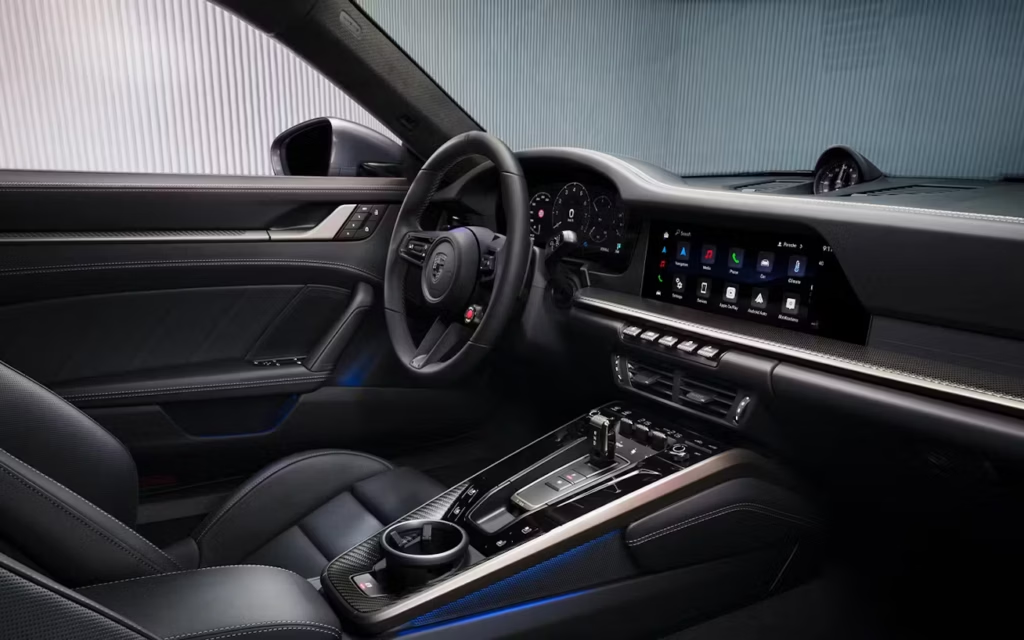
The new 911 Turbo S T-Hybrid is Porsche’s most advanced road-going 911 yet. At its core is a pair of electric-assisted turbochargers that change the way the legendary flat-six delivers power. Below, we first explain how the twin E-turbos work, then cover every other part of the car, from the powertrain and chassis to the cabin and driving experience.
The twin e-turbos: How they work
Turbocharging has always been about harnessing waste exhaust gas to drive a turbine that compresses intake air.
The weakness of that system is lag: at low revs, there isn’t enough exhaust flow to spin the turbine, so boost comes late.
Porsche’s solution is to give each turbo its own electric motor on the common shaft between turbine and compressor.
- Electric pre-spool: the moment you touch the throttle, the motor spins the compressor before exhaust flow arrives, creating immediate boost.
- Handoff to exhaust: once the exhaust stream builds, it takes over spinning the shaft; the motor switches to a regulating role to smooth transient boosts or prevent overspeed.
- Regeneration: during steady high-speed cruising, when the turbines spin faster than needed, the motors reverse into generator mode and top up the car’s 1.9 kWh high-voltage battery.
- Packaging advantage: because lag is gone, Porsche could fit slightly larger compressor wheels, improving high-rpm airflow without hurting low-rpm response.
Each E-turbo spins up to 120.000–145.000 rpm, is oil-lubricated from the engine circuit, and its motor and electronics are liquid-cooled to survive the heat. Despite the extra hardware, Porsche says no special maintenance interval is needed compared to the old turbos.
E-turbos vs traditional turbos comparison
| Feature | Traditional Turbo | Twin E-Turbo (Turbo S T-Hybrid) |
|---|---|---|
| Spool-up | Driven only by exhaust → delayed boost at low rpm | Electric pre-spins compressor → instant boost |
| Throttle response | Noticeable lag, especially after gear changes | Near-instant, linear response |
| Combustion | Often needs a richer mixture at high load to keep the turbine cool | Runs stoichiometric (λ = 1) thanks to electric assist |
| Torque delivery | Narrower band, peaks high in rev range | 800 Nm from ~2 300 rpm sustained to ~6 000 rpm |
| Thermal load | High exhaust stress at low flow | Lower thermal stress – part of the work done electrically |
| Smoothness | Can surge as boost cuts in | Seamless transitions, quieter operation |
| Service | Purely mechanical | Adds motor & cooling, yet no extra service interval |

The heart of the car: 3.6-litre T-Hybrid flat-six
The previous Turbo S used a 3.7-litre twin-turbo flat-six. For the T-Hybrid Porsche designed a new 3.6-litre flat-six, coupled with:
- Twin E-turbos: one per bank
- 8-speed PDK dual-clutch gearbox that houses a compact electric motor for torque-fill
- A self-charging 1.9 kWh high-voltage battery
- A 400-volt electrical backbone that powers the turbos, the Porsche Dynamic Chassis Control (PDCC) active anti-roll system, active aero flaps, and electric ancillaries
- Most belt-driven components, such as the coolant pump and air-con compressor, are replaced by electric units, reducing parasitic losses and lowering the engine’s profile.
Performance Highlights
- Power: 701 hp (≈ 523 kW)
- Torque: 800 Nm, plateau from about 2.300–6.000 rpm
- 0–100 km/h: 2.4 s
- 0–200 km/h: ~8.4 s
- Top speed: 322 km/h
- Nürburgring lap: 7:03.92 min – about 14 s quicker than the previous Turbo S
- Hybrid hardware weight: ≈ 80–85 kg more than before

Chassis, Aero & Brakes
To control that extra power, Porsche refined the underpinnings:
- Tyres: rear now 325/30 ZR21, the widest ever on a road-going 911
- Brakes: PCCB carbon-ceramic discs, with 410 mm rear rotors (up from 390 mm) and uprated pads
- Active aero: re-worked front splitter, under-floor diffuser, cooling flaps, and deployable rear wing, cutting drag by up to 10% in efficiency mode and improving cooling/downforce when needed
- PDCC: now electro-hydraulic on the 400-V network, reacting faster and keeping the car flatter in corners despite the extra hybrid weight
Interior, Comfort & Technology
The Turbo S remains true to its role as a daily-usable supercar, with cabin upgrades that balance luxury and function:
- Seats: standard Adaptive Sports Seats Plus, 18-way adjustable with memory, featuring Turbo S embossing on headrests
- Trim & materials: carbon-structured trim strips with neodyme inserts, Turbonite colour accents on steering wheel, dashboard and console, plus a perforated microfibre headliner
- Seating layout: the coupé comes as a two-seater by default, but rear seats can be added at no extra cost; the cabriolet ships with the full 2+2 layout
- Infotainment: 10.9-inch central touchscreen paired with a 12.6-inch curved digital driver display retaining Porsche’s five-dial look in digital form
- Audio: BOSE Surround Sound System fitted as standard
- Practicality: maintains front luggage bay and useful cabin storage; hybridisation does not reduce boot volume
These touches keep the Turbo S a refined long-distance GT when it needs to be, while still feeling special inside.

On the road: driving character
Throttle response is immediate, almost like a naturally-aspirated engine, but with the muscular mid-range punch only a turbo can give. The 800 Nm surge arrives early and stays broad, so any overtake requires only a squeeze of the pedal. Mid-corner throttle adjustments feel progressive and predictable, without the old boost-on/boost-off snap.
Repeated launch-control starts deliver consistent 2.4-second sprints, a sign of both electric torque-fill and better thermal stability. Despite the hybrid hardware, the Turbo S still behaves like the all-weather, all-purpose 911 it has always been, now simply faster, calmer, and more efficient.
Strengths and trade-offs
Strengths:
- Lag-free response from the electric pre-spool
- Broader, flatter torque band for real-world drivability
- Cleaner combustion thanks to λ = 1 fuelling under load
- Energy recuperation from the turbos during high-flow driving
- Sharper lap-time consistency and sub-2.5-second 0–100 km/h performance
Trade-offs
- Adds about 80–85 kg of hybrid hardware
- Greater system complexity from high-voltage electrics and cooling circuits

Why it matters
The 2026 911 Turbo S T-Hybrid proves that electrification can elevate a combustion sports car rather than compromise it. By electrifying its twin turbos, Porsche eliminates the age-old trade-off between instant low-end response and high-end power, delivering both in seamless harmony. It preserves the unmistakable character of the flat-six 911 while propelling the Turbo S into hyper-GT territory, quicker, cleaner, more responsive, yet still the all-weather all-rounder that made the Turbo S name legendary.



